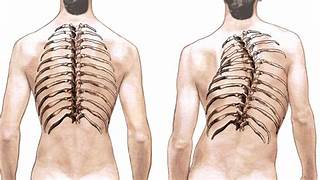
Scoliosis
Scoliosis is a medical condition characterized by abnormal lateral curvature of the spine. While a normal spine appears straight when viewed from the back, a spine affected by scoliosis curves into a C or S shape. This condition can develop at any age but is most commonly diagnosed in adolescents during their growth spurts.
Although mild scoliosis may not cause significant problems, severe cases can lead to pain, reduced lung function, and physical deformities. In this detailed guide, we will explore the causes, symptoms, diagnosis, treatment options, and preventive measures for scoliosis. By the end of this article, you will have a thorough understanding of how to manage and live with this condition.
Types of Scoliosis
This is the most common type, accounting for about 80% of all scoliosis cases. The exact cause is unknown, but it is believed to have a genetic component.
This type occurs due to abnormalities in spinal development before birth. Improperly formed vertebrae can lead to curvature as the child grows.
Conditions such as cerebral palsy, muscular dystrophy, and spinal cord injuries can cause scoliosis due to muscle weakness or imbalances.
This type develops in older adults due to age-related spinal degeneration, leading to curvature over time.
Scoliosis associated with genetic syndromes such as Marfan syndrome or Ehlers-Danlos syndrome falls under this category.
Symptoms of Scoliosis:
- Uneven shoulders: One shoulder appears higher than a other.
- Uneven waist or hips: One hip may be raised higher or more prominent.
- Visible curvature: The spine appears curved when viewed from behind.
- Back pain: Pain is more common in adults, especially with degenerative scoliosis.
- Fatigue: Caused by the strain of supporting the abnormal curvature.
- Difficulty breathing: In severe cases, the curvature can compress the lungs, making breathing difficult.
- Asymmetrical rib cage: In some cases, the ribs may stick out more on one side.
Diagnosis of Scoliosis:
- Physical Examination: A doctor checks for asymmetry in the shoulders, hips, and spine using the Adam’s forward bend test.
- X-rays: X-ray imaging provides a clear view of the spine’s curvature and its severity.
- MRI or CT Scans: In cases where additional complications are suspected, an MRI or CT scan may be required for a detailed view.
- Measuring the Cobb Angle: The Cobb angle is used to determine the degree of spinal curvature. A curvature greater than 10 degrees by considering scoliosis.
Treatment Options:
– For mild curves (under 20 degrees), especially in children who are still growing, doctors may recommend regular monitoring every 4-6 months to check for progression.
– Used for moderate curves (25-40 degrees) in children and adolescents who are still growing.
– Goal: To prevent the curve from worsening as the child grows, but it cannot correct an existing curve.
Types of Braces:
– Thoracolumbosacral Orthosis (TLSO): A common type that covers the torso.
– Milwaukee brace: A full-torso brace used for curves higher in a spine.
– Spinal Fusion: The most common surgery for scoliosis, used for severe curves (typically over 45-50 degrees) or when bracing fails to prevent progression.
– In spinal fusion, the vertebrae in the curved section of the spine are fused together using bone grafts and metal rods, screws, or hooks to hold the spine straight while the bone heals and solidifies.
– Vertebral Body Tethering (VBT): A newer, less invasive surgical option where a flexible cord is attached to the spine. It allows for some spinal flexibility or may correct the curve as the child grows.
Core-strengthening exercises, yoga, and specific scoliosis therapy can improve posture and reduce discomfort
– Pain Management: For adults with scoliosis-related back pain, treatment options like nonsteroidal anti-inflammatory drugs (NSAIDs), physical therapy, or injections (such as corticosteroids) can help manage pain.
– Chiropractic Care: While it cannot correct scoliosis, some patients find relief through spinal manipulation.
Preventing Scoliosis Progression
Low-impact exercises like swimming, yoga, and stretching strengthen the core and improve spinal alignment.
Conclusion
Scoliosis is a condition that can range from mild to severe, affecting posture, comfort, and overall well-being. While it may not always be preventable, early detection and appropriate treatment can significantly improve quality of life. Whether through physical therapy, bracing, or surgery, managing scoliosis effectively requires a proactive approach..Contact Us
By understanding the causes, symptoms, and treatment options, individuals with scoliosis can take control of their spinal health and lead fulfilling lives. If you or someone you know is experiencing symptoms of scoliosis, consulting a healthcare professional is the first step toward proper management and care.Schedule your Consultation with Dr. Ritesh Nawkhare
